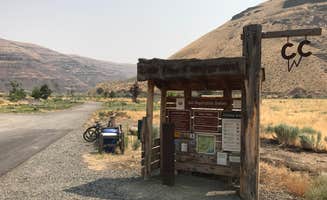Cottonwood Canyon State Park spans 8,000 acres along the John Day River, featuring rugged canyons and rocky terrain with elevations ranging from 850 to 1,200 feet. The high desert climate creates hot summers reaching 100°F and cold winters with occasional snow. Most camping areas sit directly in high wind corridors with minimal natural windbreaks, requiring secure tent stakes and proper equipment for comfortable stays.
What to do
Nighttime astronomy: Solar-powered amenities for night viewing
At Lone Tree Campground — Cottonwood Canyon State Park, many tent sites include solar panels that campers can use to charge essentials. "We brought our own bikes but if you don't bring yours, they offered loaner bikes and there were little bike workstations on the grounds," notes a visitor, highlighting the park's commitment to outdoor activities even after dark.
Nearby heritage exploration: 30 minute drive to cultural sites
Native American history can be explored at Columbia Hills Historical State Park Campground, which features accessible petroglyphs. "This was a great location for loads of hikes in the area," writes one reviewer, adding it's "close enough to the Dalles and Maryhill if your dinner went south, but far enough away where it wasn't an issue of feeling like you were in a city."
River floats: Multi-day water journeys available
The John Day River at Cottonwood Canyon provides opportunities for extended river trips. "The John Day River is easily accessible and swimmable just down from the campsite. It's great to fish, float, or hike the trails nearby," explains a camper who visits annually, highlighting the river's versatility for various water activities.
What campers like
Wildlife viewing: Early morning encounters
Dawn wildlife sightings are common at Macks Canyon Recreation Site, where campers can observe native species in their natural habitat. "We were here in 2021 and thought we'd try again. The campground is clean, and hardly anyone here. Lots of space for established camping," notes a regular visitor who appreciates the uncrowded setting conducive to wildlife observation.
Railway viewing: Historic train lines visible from camps
Many campsites offer views of active railway lines, adding historic interest to the camping experience. One visitor to Maupin City Park mentions, "No highway noise but the train tracks are across the river," indicating the proximity of transportation history to natural settings throughout the region.
Sunrise views: Eastern exposure campsites preferred
For optimal glamping in Mikkalo, Oregon area, request east-facing accommodations. "The evening I arrived was the night before a full moon, so the setting sun over the canyon and the waxing moon gave a lovely glow to the sights," reports a visitor to Cottonwood Canyon, describing the dramatic lighting that makes dawn and dusk particularly memorable.
What you should know
Wind considerations: Prepare for strong gusts
The entire Mikkalo region experiences significant wind patterns. At Crow Butte Park near Rufus, a camper notes: "As others have mentioned, the campground can be windy, although the higher numbered sites, roughly 32-50 (toward the butte, away from the mainland) tend to be calmer." This insider tip helps visitors select more sheltered locations.
Road access challenges: Variable conditions
Many access roads require high-clearance vehicles, particularly after weather events. "I have never experienced a washboard road as bad as this was for 6-7 miles. I thought the doors were going to blow off the truck," warns a camper about reaching Macks Canyon, emphasizing the importance of appropriate transportation.
Limited connectivity: Plan accordingly
Cell service is virtually non-existent throughout most glamping locations near Mikkalo. At Macks Canyon, a visitor simply states, "No cell service" with a thumbs down emoji, confirming the need to prepare for digital disconnection during your stay.
Tips for camping with families
Playground access: On-site recreation areas
Children will appreciate the recreational facilities at Morrow County OHV Park, which offers comprehensive amenities. "This place is great for families. Huge playground and lots of different types of camping available," notes a visitor, adding there are "over 300 miles of trails over 9,000 acres here" for older kids who enjoy outdoor exploration.
Wildlife education: Morning observation opportunities
Early risers can schedule morning wildlife walks to spot local species. One visitor to Cottonwood Canyon recalls, "I awoke just before dawn when my dog sat bolt upright and intently watched with me as an elk cow walked through our campsite," demonstrating how natural wildlife encounters become memorable family moments.
Water safety: Supervised swimming areas
Several campgrounds offer designated swimming locations with varying conditions. A visitor to Maupin City Park notes their experience was enhanced by "the proximity to the Imperial River Company restaurant, and quick short drive to a convenience store to restock supplies before our last day on the river," highlighting the convenience of nearby services when camping with children.
Tips from RVers
Site selection: Higher elevation preferred
At Brooks Memorial State Park Campground, RV sites on elevated ground provide better drainage during rain. "The first part of the campground is where the hook ups, large RV's, small trailers and tent campers are located. The spaces are very close together with very few trees separating spaces," notes a camper, providing context about site layout.
Hook-up limitations: Water restrictions common
Many glamping facilities near Mikkalo offer only partial hookups, so come with full tanks. "We fit just fine. This place is by the river with some shade trees. No highway noise but the train tracks are across the river. You may have to park your tow vehicle in the overflow lot across the street," explains a visitor to Maupin City Park about their 18-foot trailer experience.
Security considerations: Secure storage required
Unattended items should be properly secured at all sites. A visitor to Maupin City Park warns, "Our only issue is that our first night, at about 2am, I was woken up by footsteps outside our trailer window," highlighting the importance of bringing valuables inside overnight—even in seemingly remote locations.


